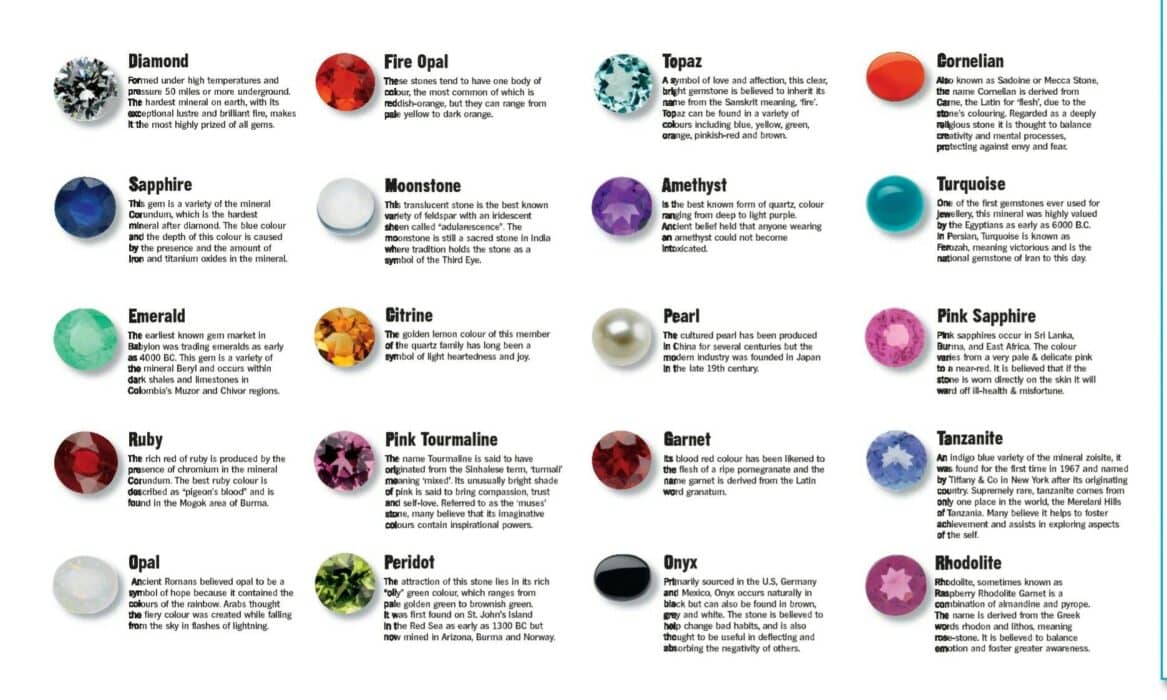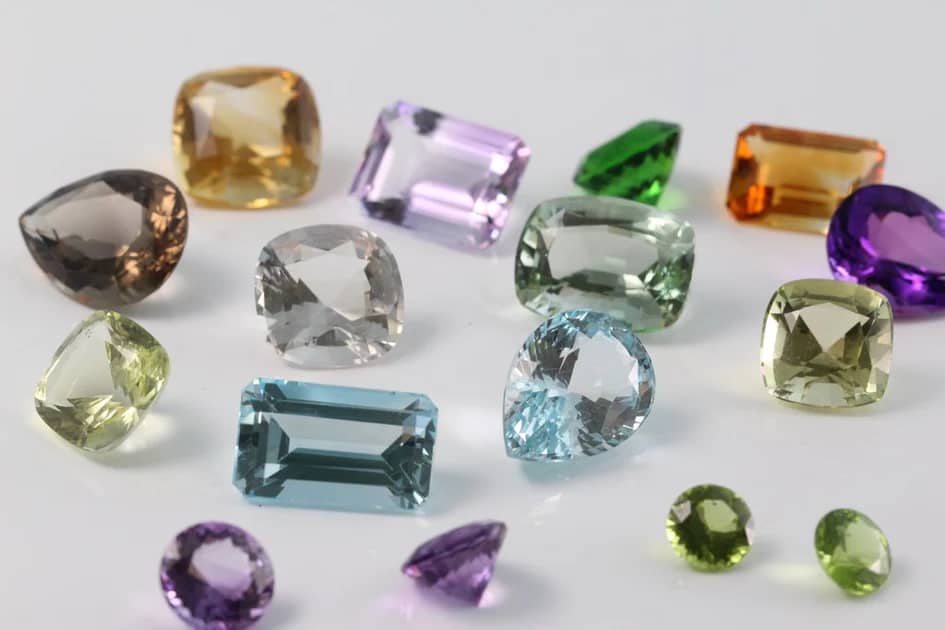Jewelry lovers have long been fascinated by gemstones and their symbolic meanings. Have you ever wondered why certain gemstones are associated with certain meanings? Are you curious as to how gemstones can be used to express yourself? Look no further! In this article, you will find all the information you need to understand gemstone meanings and symbolism.
1. The History of Gemstone Meanings and Symbolism
Gemstones have been used in jewelry and adornment for centuries, and they carry a rich history of symbolism and meaning. The spiritual and cultural significance of gemstones has been passed down through generations, and each stone has its own unique properties and associations.
The ancient Egyptians are credited with being the first culture to attribute meaning to gemstones. They believed that each stone was a living entity that could bestow magical powers and healing properties. Over the centuries, other cultures have developed their own interpretations and beliefs surrounding the use of gemstones. For example, according to Hindu mythology, the god Krishna gave the gemstone sapphire to his beloved Radha as a sign of his devotion.
In the Middle Ages, gemstones were used to ward off evil spirits and bring good luck. It was also believed that some stones could cure illnesses and improve the wearer’s luck in love. During the Renaissance, gemstones began to be associated with the planets and zodiac signs, and it became popular to wear a gemstone based on one’s birth sign.
Today, gemstones are still used in jewelry to add beauty and sparkle, but they also continue to be imbued with special meanings. Some people believe that gemstones can bring positive energy and healing to the wearer, while others simply appreciate the beauty of the stones. No matter what your beliefs are, gemstones can be a special and meaningful addition to any jewelry collection.

2. Traditional Gemstone Meanings and Symbolism
Gemstones have been used for centuries for their beauty and symbolism. While the modern-day use of gemstones is mainly for decoration, many cultures believe that they bring luck, health, and prosperity. Here is a guide to traditional gemstone meanings and symbolism.
The ancient Greeks and Romans believed that gemstones contained special powers. They used them to bring good luck, ward off evil spirits, and even cure illnesses. They also believed that the color of the stone was important. For example, blue gemstones were thought to bring peace and serenity, while red stones were thought to bring passion and strength.
In the Middle East, gemstones were thought to bring protection and good luck. In India, gemstones were believed to bring health and prosperity. In China, the color of the stone was believed to be important. For example, green gemstones were thought to bring wealth and success, while yellow stones were thought to bring happiness and joy.
In the Western world, gemstones are still believed to bring luck, protection, and prosperity. For example, the diamond is thought to bring strength and courage, while the ruby is believed to bring love and passion. The emerald is believed to bring wealth and success, while the sapphire is believed to bring wisdom and clarity.
In some cultures, gemstones are also believed to have healing properties. For example, the turquoise is believed to bring healing and good luck, while the amethyst is believed to bring calmness and protection.
3. Modern Gemstone Meanings and Symbolism
Modern gemstone meanings and symbolism reflect our current culture and beliefs. While traditional gemstones have been around for centuries, modern gemstones are often associated with a variety of different meanings. Here are some of the most popular modern gemstones and their symbolism.
Opal: Opal is associated with creativity, intuition, and inspiration. It is believed to give the wearer a greater sense of clarity and help them to think more creatively.
Aquamarine: Aquamarine is associated with courage and emotional healing. It is said to help the wearer find inner strength and clarity during difficult times.
Morganite: Morganite is associated with love and compassion. It is believed to help the wearer open their heart and find balance in relationships.
Turquoise: Turquoise is associated with protection and good luck. It is said to help the wearer ward off negative energy and attract positive vibes.
Amethyst: Amethyst is associated with spiritual growth and inner peace. It is believed to help the wearer find clarity and balance in their life.
Each of these modern gemstones has its own unique symbolism and meaning. When choosing a gemstone, it is important to consider the symbolism associated with it and how it can help you on your journey.
For a more detailed look at the meanings and symbolism associated with modern gemstones

4. Different Types of Gemstones and Their Meanings
Gemstones are not only beautiful but also have meanings and symbolism that make them special. There are different types of gemstones, each with their own unique meanings. Here are some of the most popular gemstones and their meanings:
1. Amethyst – This purple gemstone is known for its calming properties and is often associated with spirituality and intuition.
2. Ruby – The vibrant red colour of this gemstone symbolizes passion, love, and energy.
3. Emerald – This green gemstone represents growth, prosperity, and harmony.
4. Sapphire – The blue colour of this gemstone is associated with wisdom, truth, and loyalty.
5. Diamond – This classic gemstone is often associated with love, commitment, and strength.
6. Pearl – This gemstone symbolizes purity, innocence, and femininity.
7. Topaz – The golden colour of this gemstone is associated with happiness, success, and prosperity.
Knowing the meanings of different gemstones can help you choose the perfect piece of jewelry for yourself or as a gift for a loved one.
Placeholder for image/chart: [insert image/chart here]
Image/chart description: A chart showing different gemstones and their meanings.
Sources:
– https://www.gemstone.org/gemstone-information/gemstone-meanings/
– https://www.crystalvaults.com/crystal-encyclopedia/crystal-guide

5. How to Choose a Gemstone for Jewelry
When it comes to selecting the perfect gemstone for jewelry, there are many things to consider. It’s important to understand the symbolism and meaning of each gemstone, as well as the stone’s physical characteristics. Here are five tips to help you choose the perfect gemstone for your jewelry:
- Choose a stone that resonates with you. Find a stone that speaks to you and makes you feel connected to it. Gemstones can evoke powerful emotions, so pay attention to how a stone makes you feel.
- Think about color. Gemstones come in a variety of colors, so think about which color you find most appealing. Color can be an important factor in the overall look of your jewelry.
- Consider the symbolism. Different gemstones have different meanings and symbolism associated with them. Choose a stone that reflects the message you want to convey.
- Look at the stone’s clarity. Gemstones can vary in clarity, so make sure to check for any visible impurities or inclusions. The clearer the stone, the more valuable it is.
- Pay attention to the cut. Gemstones come in different cuts, from round to pear-shaped. Think about which cut will best complement the design of your jewelry.
By taking these factors into consideration, you can choose the perfect gemstone for your jewelry. For more information on gemstone meanings and symbolism,
6. Caring for Gemstone Jewelry
The beauty and symbolism of gemstone jewelry can bring joy to the wearer and those around them. To ensure that gemstone jewelry continues to bring joy, it is important to take care of it so it remains in good condition. Here are some tips for caring for gemstone jewelry:
- Store gemstone jewelry separately from other jewelry. This will help prevent scratches and other damage.
- Clean gemstone jewelry gently with a soft cloth and warm water. Avoid using chemical cleaners, as they can damage the stone.
- Keep gemstones away from extreme temperatures and direct sunlight. This can cause discoloration and damage.
- Avoid exposing gemstones to harsh chemicals, such as chlorine, ammonia, and detergents.
- Have gemstone jewelry inspected by a professional jewelry cleaner at least once a year. This will help ensure that the stones are secure and in good condition.
By following these guidelines, you can ensure that your gemstone jewelry will remain in good condition and continue to bring you joy for years to come. For more information on gemstone jewelry care, visit the Gemological Institute of America’s Jewelry Care Guide.

Conclusion:
Gemstones have captivated humanity for centuries, not just for their beauty but also for the meanings and symbolism they carry. From ancient civilizations attributing magical powers to gemstones to modern associations with zodiac signs and personal attributes, gemstones continue to hold significant cultural and personal value. Whether one believes in their healing properties or simply admires their beauty, gemstones add depth and significance to jewelry pieces.
